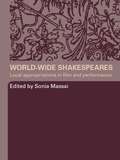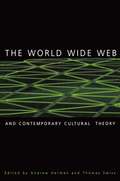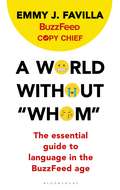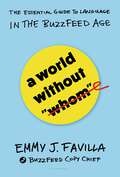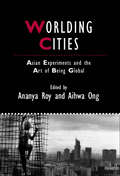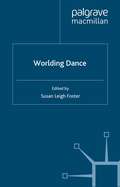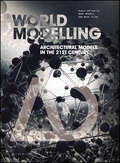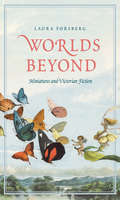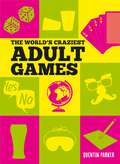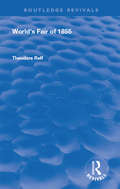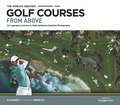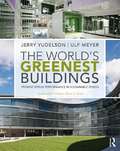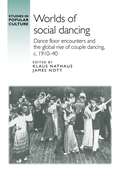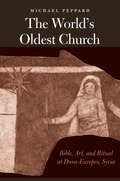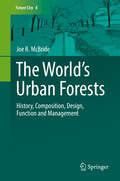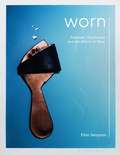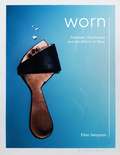- Table View
- List View
World War II warship and aircraft carrier (UEB contracted)
by RnibThis page shows two images of ships seen from the side. There is a locator dot shown, which will be at the top left of the page when the image is the correct way up. Both ships have their bow (front) on the right and the stern (back) on the left of the page. There is a thick horizontal line going from stern to bow up the middle of each ship. This is the level the ship would float at. The hull below the line would be underwater. The ship in the top of the page is a warship with lots of big guns. Sticking up from the stern deck on the left is a crane. To the right of this are two gun turrets with the gun barrels pointing horizontally to the left. The turrets would be able to rotate so the guns could fire in different directions. To the right of this is some superstructure rising to a tower with a radar dish on it. To the right of this the superstructure falls to deck level leaving a gap. Down from the gap is a small gun turret with the barrel pointing to the left at deck level. To the left is another small gun turret with the barrel pointing to the left at a slightly lower deck level. To the right of the gap is the funnel, it leans back slightly and has a slanted top. It sits on more superstructure. To the right in the top centre of the image is the radar and radio mast. Down from the mast at deck level is a small gun turret with the barrel pointing to the right. To the right is another small gun turret with the barrel pointing to the right at a slightly lower deck level. Up from this is the bridge. To the right of the superstructure are two gun turrets with the gun barrels pointing horizontally to the right. Like the rear turrets they would be also be able to rotate. The ship at the bottom of the page is an aircraft carrier. The deck is long and flat, and is used as a runway for the ship's planes. In the top centre is the superstructure. The runway goes from stern to bow on the other side of this narrow structure. Most of the cabins and rooms are below deck. There is a radio mast at the very top of the superstructure. Down and left from this is the funnel with a sloping top. At the front of the superstructure is the captain's bridge. Down from the deck at the stern there is a gallery built into the hull. To the right of this is a crane which stands on a semi-circular structure projecting out from the hull. To the right of the crane is a recess and opening into the hull. Goods can be swung into this area by the crane. In the centre of the hull is an area which projects out slightly from the hull. To the right is another gallery.
World War II warship and aircraft carrier (UEB uncontracted)
by RnibThis page shows two images of ships seen from the side. There is a locator dot shown, which will be at the top left of the page when the image is the correct way up. Both ships have their bow (front) on the right and the stern (back) on the left of the page. There is a thick horizontal line going from stern to bow up the middle of each ship. This is the level the ship would float at. The hull below the line would be underwater. The ship in the top of the page is a warship with lots of big guns. Sticking up from the stern deck on the left is a crane. To the right of this are two gun turrets with the gun barrels pointing horizontally to the left. The turrets would be able to rotate so the guns could fire in different directions. To the right of this is some superstructure rising to a tower with a radar dish on it. To the right of this the superstructure falls to deck level leaving a gap. Down from the gap is a small gun turret with the barrel pointing to the left at deck level. To the left is another small gun turret with the barrel pointing to the left at a slightly lower deck level. To the right of the gap is the funnel, it leans back slightly and has a slanted top. It sits on more superstructure. To the right in the top centre of the image is the radar and radio mast. Down from the mast at deck level is a small gun turret with the barrel pointing to the right. To the right is another small gun turret with the barrel pointing to the right at a slightly lower deck level. Up from this is the bridge. To the right of the superstructure are two gun turrets with the gun barrels pointing horizontally to the right. Like the rear turrets they would be also be able to rotate. The ship at the bottom of the page is an aircraft carrier. The deck is long and flat, and is used as a runway for the ship's planes. In the top centre is the superstructure. The runway goes from stern to bow on the other side of this narrow structure. Most of the cabins and rooms are below deck. There is a radio mast at the very top of the superstructure. Down and left from this is the funnel with a sloping top. At the front of the superstructure is the captain's bridge. Down from the deck at the stern there is a gallery built into the hull. To the right of this is a crane which stands on a semi-circular structure projecting out from the hull. To the right of the crane is a recess and opening into the hull. Goods can be swung into this area by the crane. In the centre of the hull is an area which projects out slightly from the hull. To the right is another gallery.
World-Wide Shakespeares: Local Appropriations in Film and Performance
by Sonia MassaiDrawing on debates around the global/local dimensions of cultural production, an international team of contributors explore the appropriation of Shakespeare’s plays in film and performance around the world. In particular, the book examines the ways in which adapters and directors have put Shakespeare into dialogue with local traditions and contexts. The contributors look in turn at ‘local’ Shakespeares for local, national and international audiences, covering a range of English and foreign appropriations that challenge geographical and cultural oppositions between ‘centre’ and ‘periphery’, and ‘big-time’ and ‘small-time’ Shakespeares. Responding to a surge of critical interest in the poetics and politics of appropriation, World-Wide Shakespeares is a valuable resource for those interested in the afterlife of Shakespeare in film and performance globally.
World-Wide Shakespeares: Local Appropriations in Film and Performance
by Sonia MassaiDrawing on debates around the global/local dimensions of cultural production, an international team of contributors explore the appropriation of Shakespeare’s plays in film and performance around the world. In particular, the book examines the ways in which adapters and directors have put Shakespeare into dialogue with local traditions and contexts. The contributors look in turn at ‘local’ Shakespeares for local, national and international audiences, covering a range of English and foreign appropriations that challenge geographical and cultural oppositions between ‘centre’ and ‘periphery’, and ‘big-time’ and ‘small-time’ Shakespeares. Responding to a surge of critical interest in the poetics and politics of appropriation, World-Wide Shakespeares is a valuable resource for those interested in the afterlife of Shakespeare in film and performance globally.
The World Wide Web and Contemporary Cultural Theory: Magic, Metaphor, Power
by Andrew Herman Thomas SwissEngaging the thematic issues of the Web as a space where magic, metaphor, and power converge, the chapters cover such subjects as The Web and Corporate Media Systems, Conspiracy Theories and the Web; The Economy of Cyberpromotion, The Bias of the Web, The Web and Issues of Gender, and so on.
The World Wide Web and Contemporary Cultural Theory: Magic, Metaphor, Power
by Andrew Herman Thomas SwissEngaging the thematic issues of the Web as a space where magic, metaphor, and power converge, the chapters cover such subjects as The Web and Corporate Media Systems, Conspiracy Theories and the Web; The Economy of Cyberpromotion, The Bias of the Web, The Web and Issues of Gender, and so on.
A World Without "Whom": The Essential Guide to Language in the BuzzFeed Age
by Emmy J. Favilla BuzzFeedEats, Shoots & Leaves for the internet age As language evolves faster than ever before, what is the future of 'correct' writing? When Emmy Favilla was tasked with creating a styleguide for BuzzFeed, she opted for spelling, grammar and punctuation guidelines that would reflect how readers actually use language IRL. With wry humour and an uncanny intuition for the possibilities of internet-age expression, Favilla makes a case for breaking the stuffy rules that have hitherto defined our relationship with language. Featuring priceless emoji strings, sidebars, quizzes and style debates among the most lovable word nerds of the digital media world – of which Favilla is the go-to style guru – A World Without “Whom” is essential for readers and writers of posts, tweets, texts, emails and whatever comes next.
A World Without "Whom": The Essential Guide to Language in the BuzzFeed Age
by Emmy J. Favilla BuzzFeed"A provocative and jaunty romp through the dos and don'ts of writing for the internet" (NYT)--the practical, the playful, and the politically correct--from BuzzFeed copy chief Emmy Favilla.A World Without "Whom" is Eats, Shoots & Leaves for the internet age, and BuzzFeed global copy chief Emmy Favilla is the witty go-to style guru of webspeak. As language evolves faster than ever before, what is the future of "correct" writing? When Favilla was tasked with creating a style guide for BuzzFeed, she opted for spelling, grammar, and punctuation guidelines that would reflect not only the site's lighthearted tone, but also how readers actually use language IRL. With wry cleverness and an uncanny intuition for the possibilities of internet-age expression, Favilla makes a case for breaking the rules laid out by Strunk and White: A world without "whom," she argues, is a world with more room for writing that's clear, timely, pleasurable, and politically aware. Featuring priceless emoji strings, sidebars, quizzes, and style debates among the most lovable word nerds in the digital media world--of which Favilla is queen--A World Without "Whom" is essential for readers and writers of virtually everything: news articles, blog posts, tweets, texts, emails, and whatever comes next . . . so basically everyone.
Worlding Cities: Asian Experiments and the Art of Being Global (IJURR Studies in Urban and Social Change Book Series #42)
by Ananya Roy Aihwa OngWorlding Cities is the first serious examination of Asian urbanism to highlight the connections between different Asian models and practices of urbanization. It includes important contributions from a respected group of scholars across a range of generations, disciplines, and sites of study. Describes the new theoretical framework of ‘worlding’ Substantially expands and updates the themes of capital and culture Includes a unique collection of authors across generations, disciplines, and sites of study Demonstrates how references to Asian power, success, and hegemony make possible urban development and limit urban politics
Worlding Cities: Asian Experiments and the Art of Being Global (IJURR Studies in Urban and Social Change Book Series #41)
by Ananya Roy Aihwa OngWorlding Cities is the first serious examination of Asian urbanism to highlight the connections between different Asian models and practices of urbanization. It includes important contributions from a respected group of scholars across a range of generations, disciplines, and sites of study. Describes the new theoretical framework of ‘worlding’ Substantially expands and updates the themes of capital and culture Includes a unique collection of authors across generations, disciplines, and sites of study Demonstrates how references to Asian power, success, and hegemony make possible urban development and limit urban politics
Worlding Dance (Studies in International Performance)
by S. FosterWhat world has been constructed for dancing through the use of the term 'world dance'? What kinds of worlds do we as scholars create for a given dance when we undertake to describe and analyze it? This book endeavours to make new epistemological space for the analysis of the world's dance by offering a variety of new analytic approaches.
Worldmodelling: Architectural Models in the 21st Century (Architectural Design)
by Mark Morris Mike AlingIn light of current developments in modelling, and with the aim of reinvigorating debates around the potentiality of the architectural model – its philosophies, technologies and futures – this issue of AD examines how the model has developed to become an immersive worldbuilding machine. Worldbuilding is the creation of imaginary worlds through forms of cultural production. Although this discourse began with an analysis of imaginary places constructed in works of literature, it has evolved to encompass worlds from fields such as cinema, games, design, landscape, urbanism and architecture. Worldbuilding differs from the notion of worldmaking, which deals with how speculative thinking can influence the construction of the phenomenal world. As architects postulate ever-increasingly complex world models from which to draw inspiration and inform their practice, questions of scale, representation and collaboration emerge. Discussed through a range of articles from acclaimed international contributors in the fields of both architecture and media studies, this issue explores how the architectural model is situated between concepts of worldbuilding and worldmaking – in the creative space of worldmodelling. Contributors: Kathy Battista, Thea Brejzek and Lawrence Wallen, Pascal Bronner and Thomas Hillier, Mark Cousins, James A Craig and Matt Ozga-Lawn, Kate Davies, Ryan Dillon, Christian Hubert, Chad Randl, Theodore Spyropoulos, and Mark JP Wolf. Featured architects: Phil Ayres, FleaFolly Architects, Minimaforms, and Stasus.
Worlds Beyond: Miniatures and Victorian Fiction
by Laura ForsbergAn innovative study of how the Victorians used books, portraits, fairies, microscopes, and dollhouses to imagine miniature worlds beyond perception In 1856, Elizabeth Gaskell discovered a trove of handmade miniature books that were created by Charlotte and Branwell Brontë in their youth and that, as Gaskell later recalled, “contained an immense amount of manuscript, in an inconceivably small space.” Far from being singular wonders, these two-inch volumes were part of a wide array of miniature marvels that filled the drawers and pockets of middle- and upper-class Victorians. Victorian miniatures pushed the boundaries of scientific knowledge, mechanical production, and human perception. To touch a miniature was to imagine what lay beyond these boundaries. In Worlds Beyond, Laura Forsberg reads major works of fiction by George Eliot, Jane Austen, Charles Dickens, and Lewis Carroll alongside minor genres like the doll narrative, fairy science tract, and thumb Bible. Forsberg guides readers through microscopic science, art history, children’s culture, and book production to show how Victorian miniatures offered scripts for expansive fantasies of worlds beyond perception.
The World's Craziest Adult Games
by Quentin ParkerDo you want to jazz up your dinner parties or get-togethers? Are you looking for exciting new games to play at your wild house parties? With old classics like Spoons and the Cereal Box Game, alongside new gems waiting to be discovered such as Mafia and Slip It In, this is the only book you need to become a legendary party host.
World's Fair of 1855 (Routledge Revivals)
by Theodore ReffPublished in 1981: This is two-hundred catalogues of the Major Exhibitions reproduced in facsimile in forty-seven volumes.
World's Fair of 1855 (Routledge Revivals)
by Theodore ReffPublished in 1981: This is two-hundred catalogues of the Major Exhibitions reproduced in facsimile in forty-seven volumes.
The World's Greatest Golf Courses From Above: 34 Legendary Courses in High-Definition Satellite Photographs
by Alex NareyGolfers forever dream about playing in the most iconic locations, such as the beautiful Augusta National, the testing Valderrama or the legendary St Andrews, and The World's Greatest Golf Courses From Above provides them with a unique perspective of these great golf challenges.Each of the world's most celebrated courses is illustrated using Google Earth's incredible satellite imagery and then described in expert detail as the author explains course history and design, signature holes and tactics for playing them.Featuring 34 iconic courses and 250 stunning photographs, golfers will get a feel for taking on some of the greatest holes in world golf. As well as featuring essential information such as yardage and course cut, the book gives the reader a unique insight into the challenges and personality of each hole.The World's Greatest Golf Courses From Above brings the most celebrated courses vividly to life and is the next best thing to actually playing them.
The World's Greenest Buildings: Promise Versus Performance in Sustainable Design
by Jerry Yudelson Ulf MeyerThe World’s Greenest Buildings tackles an audacious task. Among the thousands of green buildings out there, which are the best, and how do we know? Authors Jerry Yudelson and Ulf Meyer examined hundreds of the highest-rated large green buildings from around the world and asked their owners to supply one simple thing: actual performance data, to demonstrate their claims to sustainable operations. This pivotal book presents: an overview of the rating systems and shows "best in class" building performance in North America, Europe, the Middle East, India, China, Australia and the Asia-Pacific region practical examples of best practices for greening both new and existing buildings a practical reference for how green buildings actually perform at the highest level, one that takes you step-by-step through many different design solutions a wealth of exemplary case studies of successful green building projects using actual performance data from which to learn interviews with architects, engineers, building owners and developers and industry experts, to provide added insight into the greening process This guide uncovers some of the pitfalls that lie ahead for sustainable design, and points the way toward much faster progress in the decade ahead.
The World's Greenest Buildings: Promise Versus Performance in Sustainable Design
by Jerry Yudelson Ulf MeyerThe World’s Greenest Buildings tackles an audacious task. Among the thousands of green buildings out there, which are the best, and how do we know? Authors Jerry Yudelson and Ulf Meyer examined hundreds of the highest-rated large green buildings from around the world and asked their owners to supply one simple thing: actual performance data, to demonstrate their claims to sustainable operations. This pivotal book presents: an overview of the rating systems and shows "best in class" building performance in North America, Europe, the Middle East, India, China, Australia and the Asia-Pacific region practical examples of best practices for greening both new and existing buildings a practical reference for how green buildings actually perform at the highest level, one that takes you step-by-step through many different design solutions a wealth of exemplary case studies of successful green building projects using actual performance data from which to learn interviews with architects, engineers, building owners and developers and industry experts, to provide added insight into the greening process This guide uncovers some of the pitfalls that lie ahead for sustainable design, and points the way toward much faster progress in the decade ahead.
Worlds of social dancing: Dance floor encounters and the global rise of couple dancing, c. 1910–40 (Studies in Popular Culture)
by Jeffrey RichardsBy the 1920s, much of the world was ‘dance mad,’ as dancers from Buenos Aires to Tokyo, from Manchester to Johannesburg and from Chelyabinsk to Auckland, engaged in the Charleston, the foxtrot and a whole host of other fashionable dances. Worlds of social dancing examines how these dance cultures spread around the globe at this time and how they were altered to suit local tastes. As it looks at dance as a ‘social world’, the book explores the social and personal relationships established in encounters on dance floors on all continents. It also acknowledges the impact of radio and (sound) film as well as the contribution of dance teachers, musicians and other entertainment professionals to the making of the new dance culture.
Worlds of social dancing: Dance floor encounters and the global rise of couple dancing, c. 1910–40 (Studies in Popular Culture)
by Jeffrey RichardsBy the 1920s, much of the world was ‘dance mad,’ as dancers from Buenos Aires to Tokyo, from Manchester to Johannesburg and from Chelyabinsk to Auckland, engaged in the Charleston, the foxtrot and a whole host of other fashionable dances. Worlds of social dancing examines how these dance cultures spread around the globe at this time and how they were altered to suit local tastes. As it looks at dance as a ‘social world’, the book explores the social and personal relationships established in encounters on dance floors on all continents. It also acknowledges the impact of radio and (sound) film as well as the contribution of dance teachers, musicians and other entertainment professionals to the making of the new dance culture.
The World's Oldest Church: Bible, Art, and Ritual at Dura-Europos, Syria (Synkrisis)
by Michael PeppardMichael Peppard provides a historical and theological reassessment of the oldest Christian building ever discovered, the third-century house-church at Dura-Europos. Contrary to commonly held assumptions about Christian initiation, Peppard contends that rituals here did not primarily embody notions of death and resurrection. Rather, he portrays the motifs of the church’s wall paintings as those of empowerment, healing, marriage, and incarnation, while boldly reidentifying the figure of a woman formerly believed to be a repentant sinner as the Virgin Mary. This richly illustrated volume is a breakthrough work that enhances our understanding of early Christianity at the nexus of Bible, art, and ritual.
The World’s Urban Forests: History, Composition, Design, Function and Management (Future City #8)
by Joe R. McBrideThe purpose of this book is to examine urban forests in cities around the world. It will ask questions about the history, composition, structure, and management of trees in urban areas. Data for this book was collected in 33 cities across broad geographical areas known as biomes. Constraints and opportunities imposed on urban forest composition, design, and management by the ecological characteristics of these biomes will be examined. The book will also address the cultural and historical factors that influenced the characteristics of urban forests around the world.
Worn: Footwear, Attachment and the Affects of Wear
by Ellen SampsonIn a culture preoccupied with newness and a fashion system largely predicated upon it, what is the significance of worn clothes and why do they have the power to affect us so deeply? How are relationships to clothing produced and maintained through the embodied practices of wearing, maintenance and repair? Through a focus upon a single garment, the shoe, this book calls on readers to reconsider the value of the marks of wear at a time when fast fashion reigns supreme and interest in damaged, or worn, garments quietly increases.Originating in an experimental practice-based methodology which placed wearing at its center, this book presents the act of wearing as a tool for developing knowledge, of 'being in' or 'being with', rather than observing from the outside. Bringing together anthropological and psychoanalytic theory with practices of handmaking, wearing, and photography, this book asks what is the embodied experience of wearing and the affect of the worn? Beautifully illustrated in full color throughout, Worn is the first book to focus exclusively on the significance of imperfect garments as important aspects of our material world and culture.
Worn: Footwear, Attachment and the Affects of Wear
by Ellen SampsonIn a culture preoccupied with newness and a fashion system largely predicated upon it, what is the significance of worn clothes and why do they have the power to affect us so deeply? How are relationships to clothing produced and maintained through the embodied practices of wearing, maintenance and repair? Through a focus upon a single garment, the shoe, this book calls on readers to reconsider the value of the marks of wear at a time when fast fashion reigns supreme and interest in damaged, or worn, garments quietly increases.Originating in an experimental practice-based methodology which placed wearing at its center, this book presents the act of wearing as a tool for developing knowledge, of 'being in' or 'being with', rather than observing from the outside. Bringing together anthropological and psychoanalytic theory with practices of handmaking, wearing, and photography, this book asks what is the embodied experience of wearing and the affect of the worn? Beautifully illustrated in full color throughout, Worn is the first book to focus exclusively on the significance of imperfect garments as important aspects of our material world and culture.

